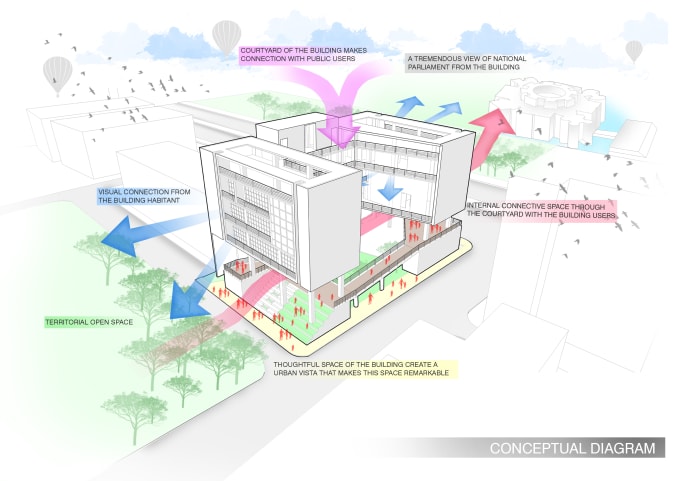Unveiling Creative Clarity: A Review of Professional Architectural Concept Diagrams
For only $15, A26tasnim will design professional architectural concept diagrams. | Do you need professional architectural diagram / analysis ? I’mglad to help you ! Thanks for your interest in me :)I am an Architect & | Fiverr
👉 Reviews! / See all reviews 💯

Do you need professional architectural diagram / analysis ? I’m glad to help you ! Thanks for your interest in me 🙂
I am an Architect & Designer. I take great pride in my work and find joy in solving visual problems to deliver flawless imagery, both on time and within budget.
New challenges keep me motivated and also help to further develop my skills. I’m excited to have the opportunity to share these skills with you and create something new together.
I will help you with your architectural projects, I can create architectural drawings (Plans, Sections, Elevations), renders, Diagrams and presentations. I love what I am doing, I am very flexible and punctual, and I am very excited to work with you.
Before you place your order:
* Due to the nature of projects, the price might be modified according to the project’s requirements ( I can provide you the work as shown in the gallery or even more better than that as your needs)
Looking forward to working with you!!
Thank You.
Shuchita Tasnim
## Professional Architectural Concept Diagrams: Designing the Foundation of Your Dream Space
### Introduction
Architectural concept diagrams are the cornerstone of any successful building or renovation project. They serve as a visual representation of the architect’s vision, providing stakeholders with a clear understanding of the project’s scope, design, and functionality. Professional architectural concept diagrams are meticulously crafted to convey complex design ideas in a visually appealing and easily comprehensible manner.
### The Importance of Concept Diagrams
A well-executed architectural concept diagram:
– **Establishes a shared understanding:** It allows architects, clients, and builders to visualize the project and align their expectations.
– **Identifies design opportunities and constraints:** By graphically representing the design, potential issues can be identified and addressed early on.
– **Facilitates effective communication:** Concept diagrams provide a common language for stakeholders, reducing misinterpretations and ensuring everyone is on the same page.
– **Serves as a basis for subsequent design phases:** They form the foundation for detailed drawings, specifications, and construction plans.
### The Elements of Professional Concept Diagrams
Professional architectural concept diagrams typically include the following elements:
– **Site plan:** Outlines the project’s location, orientation, and relationship to the surrounding environment.
– **Floor plan:** Shows the layout of rooms, circulation paths, and functional areas.
– **Elevations:** Depict the exterior appearance of the building from different angles.
– **Sections:** Reveal the interior structure and details, including materials and finishes.
– **Diagrams and annotations:** Provide additional information about design concepts, materials, and construction methods.
### The Design Process
Creating professional architectural concept diagrams involves a collaborative process between architects and clients. It typically follows these steps:
1. **Program development:** Defining the project’s purpose, scope, and functional requirements.
2. **Site analysis:** Understanding the site’s physical characteristics, zoning regulations, and environmental factors.
3. **Schematic design:** Generating initial design concepts and exploring various alternatives.
4. **Concept development:** Refining and detailing the design, incorporating feedback from stakeholders.
5. **Presentation:** Presenting the final concept diagrams to clients for review and approval.
### Choosing the Right Architect
Selecting the right architect is crucial for ensuring the quality of your architectural concept diagrams. Consider the following factors:
– **Experience:** Seek architects with a proven track record in designing similar projects.
– **Portfolio:** Review their portfolio to assess the quality and style of their work.
– **Communication:** Choose an architect who is responsive, understands your vision, and can translate it into effective designs.
– **Technology:** Look for architects who utilize advanced design tools and technologies to enhance the accuracy and clarity of their concept diagrams.
### Benefits of Professional Concept Diagrams
Investing in professional architectural concept diagrams offers numerous benefits:
– **Improved project outcomes:** Clear and comprehensive diagrams reduce design errors and miscommunications, leading to a smoother construction process.
– **Reduced project costs:** Identifying design issues early on saves time and resources during the construction phase.
– **Enhanced stakeholder satisfaction:** By involving stakeholders in the design process, their input is incorporated, resulting in greater satisfaction with the final project.
– **Timely project delivery:** Efficient communication and early problem identification accelerate project completion.
### Conclusion
Professional architectural concept diagrams are indispensable tools in the design process. They provide a visual roadmap for the project, facilitating effective communication, identifying design opportunities, and ensuring project success. By choosing the right architect and investing in high-quality concept diagrams, you can lay the foundation for a truly exceptional building or renovation.
Leave a Reply